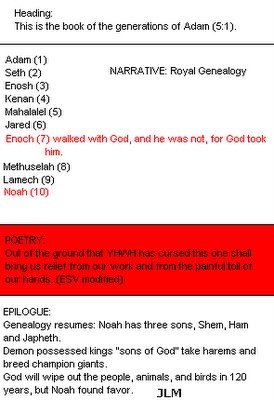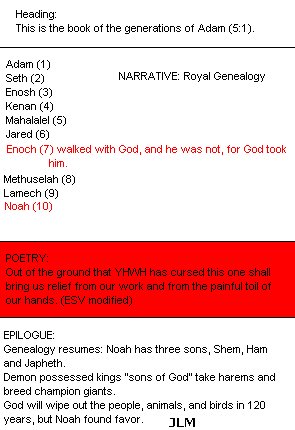 The second book in Genesis begins with the title “This is the book of the generations of Adam” (Gen 5:1). Thus we will find out about the descendants of Adam.
The second book in Genesis begins with the title “This is the book of the generations of Adam” (Gen 5:1). Thus we will find out about the descendants of Adam.
We should identify the genre of the narrative and part of the epilogue as a royal genealogy. Up until now I have not spoken much about the similarities of Genesis and literature from the surrounding ANE world. But this genre identification is important because the tendency of some is to try to date the earth based on mathematically analyzing texts like this. Waltke’s commentary mentions the Sumerian king list, which could skip over many generations. Likewise, in Scripture the father/son relationship could also be a grandfather/grandson (or any number of generations) relationship. The purpose of this text is not scientific. It is a royal genealogy pointing us to the legitimacy of Israel (and ultimately Jesus Christ) as the heir of the promise to the woman. And thus the genealogy conforms to a pattern we will analyze later.
Genealogies are one of the most skimmed things in Scripture, but the genealogies in Genesis are some of the most fascinating texts. One of the really interesting things is the ages of the Sethites. Waltke cites M. Barnouin (who wrote in French) who has observed that the ages of the Sethites are equal to particular astronomical periods known to the Babylonians. Enoch’s 365 years are the same number of days of the year. Lamech’s 777 years (not to be confused with the Lamech in the last book) are the same as the synodic periods of Jupiter plus Saturn (this just means how long it takes for the planet to get back around to the same place in the sky). And Jared’s 962 years are the same as the synodic periods of Venus plus Saturn. Moreover, Waltke says,
“If the sum of the years at the time of fathering and of the total life spans from Adam to Lamech are each divided by sixty–based on the Babylonian sexagesimal system–the sum of the remainders is 365, again perhaps representing the perfect life span. The cycles of a man’s years may match the cycles of the heavenly spheres to show that their lives follow a meaningful pattern and end with a completed cycle.”
So even though 365 is short compared to the lifespans of the others in the genealogy, Enoch was a very important man.
This is confirmed when we observe the pattern of the text. The pattern is: When X had lived Y years, he fathered…Z, The days of X after he fathered Z were ZZ years; and had other sons and daughters. Thus all the days that X lived were ZZZ years, and he died. For Adam the pattern is more expansive than the rest. For example, for ‘he fathered Z’ it says, “he fathered a son in his own likeness, after his image, and named him Seth.” This line is also expanded for Lamech, the text says, “he fathered a son and called his name Noah, saying…” Any major variations of the pattern should stop us in our tracks as we read the genealogy. When we get to number three (Adam, Seth, Enosh) we find the basic pattern. Same with number four, Kenan; five, Mahalalel; and six, Jared. But as we should have guessed from the symbolic significance of seven (not to mention the crafting of the genealogy we saw in the last book) the pattern is broken for Enoch who lives the perfect lifespan. Instead of saying, ‘Enoch lived after he fathered Methuselah 300 years’ it says, “Enoch walked with God after he fathered…” And where we would expect the text to tell us, “and he died” it says, “Enoch walked with God, and he was not, for God took him. Enoch’s son has the longest recorded lifespan (according to Scripture) 969 years. And Enoch himself could have lived longer than his son, but it is far better to be with God.
The pattern resumes only to be broken again for number ten. Ten means fullness. Therefore, at the fullness of time, God sent forth his son Noah (cf. Galatians 4:4). Thus the longer form of he fathered: “he fathered a son and called his name Noah, saying, ‘Out of the ground that YHWH has cursed this one shall bring us relief from our work and from the painful toil of our hands'” (Gen 5:29). Here we see the same overall pattern for most of these books applies to this second book as well (heading, narrative, poetry, epilogue). And remember that we said the poetry is what is most important. Noah gives rest and joy to the people of God through raising a vineyard. Of course, this points forward to Jesus Christ, the son of God born at the fullness of time, who gives us rest and joy everlasting.
The epilogue continues the royal genealogy and adds the plus one generation has three sons, Shem, Ham and Japheth. The next book will be about them and unlike most of the books it will also be about Noah as it does not tell us “and he died” quite yet. The epilogue continues to prepare us for the next book and to set the stage. Traditionally the problem has been explained as the sons of Seth intermarrying with the daughters of Cain. But, following Meredith Kline, it is much more plausible (for grammatical, contextual and other reasons) to read “sons of God” as a title of kingship. Since “sons of God” also sometimes refers to angels, it is not a stretch to say that these kings are demon-possessed. The text then is talking about demon-possessed kings (the sons of Cain) taking harems (“they took as their wives any they chose,” Gen 6:2) and breeding champions for their army (the Nephilim). The Nephilim are giants sometimes called Anakim. Anak was a person who is the ancestor of many giants and Nephil is the place where giants lived. See Numbers 13:33. Without a doubt, all giants are then called Nephilim. Sin has continued to escalate to a climax demanding judgment. Now we see more than just polygamy and murder but harems and marauding armies. “But Noah found favor in the eyes of YHWH” (Gen 6:8).
It is also worth noting that before the flood “every intention of the thoughts of his heart was only evil continually” (Gen 8:5) and after the flood “the intention of man’s heart is evil from his youth” (Gen 8:21). The circumcision of the heart has not yet taken place. God has started over but the problem of sin is not yet answered. This is the difference when God starts over with Jesus Christ and He pours out the Spirit.

Recent Comments